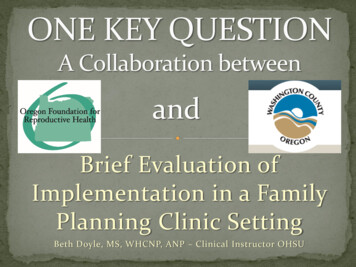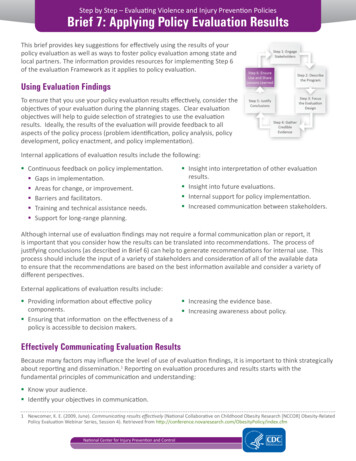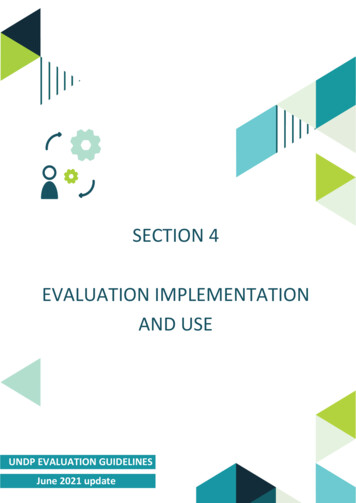
Transcription
andBrief Evaluation ofImplementation in a FamilyPlanning Clinic SettingBeth Doyle, MS, WHCNP, ANP – Clinical Instructor OHSU
OREGON STATISTICS2008 – 36,000 Unintended Pregnancies –73% were considered miss-timed27% were unwanted31% ended in elective terminations2011 – 43.5% of all pregnancies wereunintended.2011 – 48.7% of women were not taking folicacid in the month before they becamepregnant
One Key QuestionAsk all women of child bearing age seenfor a clinical visit:“Do you want tobecome pregnantin the next year?”
Preconception CounselingFOLIC ACIDNUTRITION COUNSELINGDIABETES SCREENINGSMOKING CESSATIONSUBSTANCEABUSETEIREDCOUNSELINGACCESS TO OPTIONSPATIENT CENTERED CARELONG-ACTING, REVERSIBLECONTRACEPTION (LARC)Contraceptive Access
Assumptions: The provider will ask the question! Asking the question will direct theprovider to give more appropriate care Providing services directed at thepatients’ stated goals empowers themto make better reproductive plans fortheir future Preconceptual counseling can improvepregnancy outcomes.
ONE KEY QUESTION at Washington County HHS – LOGIC MODEL FLOW CHARTResourcesFundingClinic Staff: RN,NP and OfficePreconceptionInformationClinic FP andSTD PatientsBCM Info andSuppliesOregon Foundationfor ReproductiveHealthStaff andPatient surveysActivitiesAsking theQuestionPreconceptionCounselingEducationabout andprovision ofContraceptiveMethodsCompletethe SurveyCollect theSurveyOutputsOutcomesGoals500 Surveyscompleted in 3months80% of patientsreport beingasked the keyquestion90% of patientsreportreceiveing info/supplies thatsupport theiranswer80% of pts notseeking preg,leave w/ equalor better BCMthan theystarted withAssumptions: 1) Asking the question will direct the provider to givemore appropriate care; 2) Providing services directed at the patients’stated goals empowers them to make better reproductive plans for theirfuture; 3) Preconceptual counseling can improve pregnancy outcomes.Patients areempoweredto makereproductivehealthdecisionsAsking OKQbecomeshabitual xternal Factors: 1) Patients may not change behavior despitecounseling and/or resources provided; 2) One Key Question is aimedat integration of reproductive health into primary care, which WashCodoes not provide.
Four Output Benchmarks – Set Prior toEvaluation Process#1 - 500 Surveyscompleted in 3months#3 - 90% of patientsreport receiveinginfo/supplies thatsupport their answer#2 - 80% ofpatients reportbeing asked thekey question#4 - 80% of pts notseeking preg, leave w/equal or better BCMthan they started with
500 Surveyscompleted in 3months#1 Accomplished!!500 number-matched surveys of bothpatients and providers were completedbetween July 14 and Aug 15, 2014. Thesewere then matched with patient demographicinformation: Age, Race, Ethnicity, PrimaryLanguage and city.
80% of patientsreport beingasked the keyquestion#2 –UnsuccessfulOf the 500 patients surveyed immediatelyat the end of their clinic visits, only 66.4%reported being asked if they wanted tobecome pregnant in the next year.
Language Distribution.8%36%63%EnglishOtherEnglish speakingpatients reportthat OKQ wasasked at 70.3 %of their visits.SpanishSpanish Speaking patients report being askedOKQ at only 64.5% of their visitsSignificant, yes, but not a statistically significantdifference – p 0.187
90% of patientsreport receiveinginfo/ supplies thatsupport their answerOf patients seekingpregnancy, only 67.7%reported receiving info onfolic acid, and only 61%reported receiving info onplanning for healthypregnancy#3 –UnsuccessfulOf patients not wantingto become pregnant, only65.8% reported receivingtheir chosen BCM andonly 31.6% reportedreceiving information onBCM options
80% of pts notseeking preg, leave w/equal or better BCMthan they started with#4 –Accomplished!!Of the 443 patients who were noted asNOT wanting to become pregnant in thenext year, 438 (98.87%) left the clinic withan equally reliable or more reliablemethod than they came in with.
Conclusions:1 ) Providers perception of how well they are meetingpatients’ may be very different from patient perception onhow needs are met.2) Even in a Clinic where Family Planning is the stated aim,we can miss the mark as far as truly helping our patientsplan their reproductive choices.3) More work is needed to assure that providers provide theservices most appropriate to patients needs andreproductive life plan.4) This could serve well as a baseline for a repeated study tosee if outcomes can be improved with further providereducation.
THANKS TO:The Staff and patients of Washington County HealthDepartment for their time and willingness toparticipate.Dr. Katherine Bradley - for starting my interest inProgram Evaluation in the first place.Dr. Corey Nagel – for teaching statistics and helpingcrunch the numbers.
NP and Office Clinic FP and STD Patients Preconception Information Oregon Foundation for Reproductive Health Resources Outputs Asking the Question Preconception Counseling Education about and provision of Contraceptive Methods Complete the Survey Collect the Survey Activities 80% of patients report being asked the key question 90% of patients











